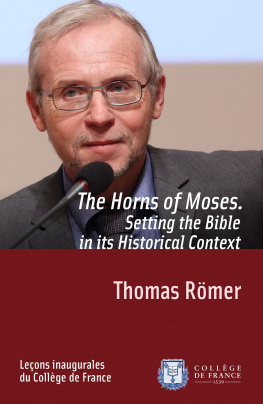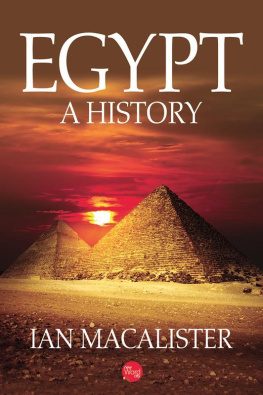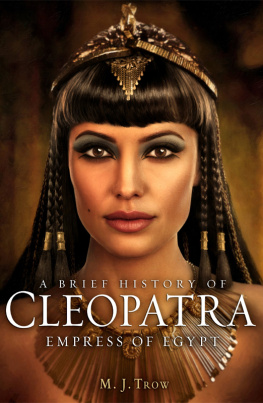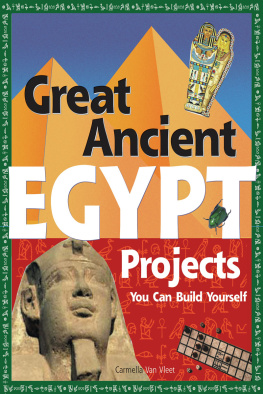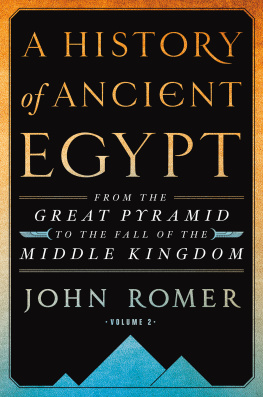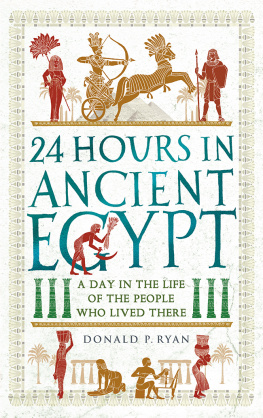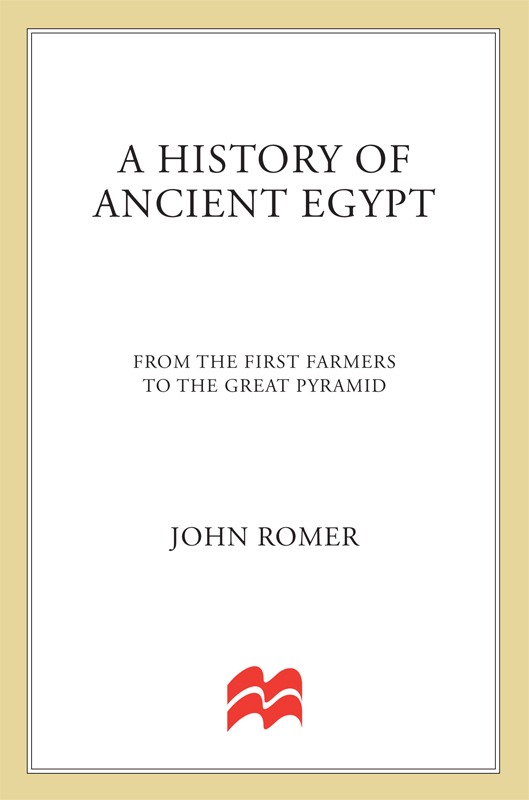Dont miss John Romers next incredible volume

Available March 2017

The author and publisher have provided this e-book to you for your personal use only. You may not make this e-book publicly available in any way. Copyright infringement is against the law. If you believe the copy of this e-book you are reading infringes on the authors copyright, please notify the publisher at: us.macmillanusa.com/piracy.
Contents
PART ONE
Making Culture (50003000 BC )
PART TWO
Making Pharaoh (3200 3000 BC )
PART THREE
Making a Kingdom (3000 2650 BC )
PART FOUR
Step Pyramid (2675 2650 BC )
PART FIVE
Building Ancient Egypt (2650 2550 BC )
For my Egyptian friends
Preface
You ask me whether the Orient is up to what I imagined it to be. Yes, it is; and more than that, it extends far beyond the narrow idea I had of it Facts have taken the place of suppositions so excellently so that it is often as though I were suddenly coming upon old forgotten dreams.
Flaubert to his mother, Cairo, 5 January 1850
Given its continuing and unrivalled popularity, you might imagine that there are many good contemporary histories of ancient Egypt: in fact, they are extremely rare. Certainly, you would never guess that since the 1960s some brilliant academic research has revolutionized our understanding of the ancient past, or that a series of ongoing archaeological excavations is presently reshaping an entire millennium of ancient Egypts early history. Instead of making modern histories, most writers unthinkingly insert the products of a century and more of the most meticulous scientific research into narratives founded in nineteenth-century theories about human nature and the rise and fall of nation-states. So ancient Egypt yet labours in a European bondage of a grand scholarly tradition, and it is subject to both the vices and virtues of that most powerful heritage.
The first great modern history of ancient Egypt was published in Paris in the 1730s and had a huge and immediate effect. Written by an elderly rector of the city university, it was swiftly translated into all the major European languages and continuously reprinted in dozens of different editions and for so long, that the last English edition of Mr Rollins Ancient History of the Egyptians, Carthaginians, Assyrians, Babylonians, Medes and Persians, Macedonians and Grecians appeared in 1924!
Starting with the Book of Genesis, when the world was without form and void, Rollin introduces the first pharaoh as Noahs grandson, who had ascended to the throne, according to his calculations, in the 1,816th year of the world which, by seventeenth-century lights, had been created in 4004 BC . As a shrewd contemporary had observed, it was not the rectors erudition or the benevolence of his intentions that had led to his books success but above all, the piety of his sentiments, which clash with no sect or party among Christians.
Whatever its historical merits, Rollins history laid down the principles by which egyptology is conducted to this day, the titles of its three main sections eerily foreshadowing some of the greatest egyptological publications of the following centuries: 1. A Description of Egypt, 2. The Manners and Customs of the Egyptians, 3. The History of the Kings of Egypt and all of that in 30,000 words which, in Rollins time, was sufficient to contain the bulk of Western knowledge about the ancient culture.
The last of the great histories of ancient Egypt to be written by a single scholar was completed by Sir Alan Gardiner in 1961 when he was over eighty, and is five times as long as that of Rector Rollin. Between them, the two histories mark the beginning and the ending of a scholarly tradition. Both Gardiner and Rollin were products of the classical humanist European schools, and both their histories had been based on ancient texts, their authors sharing the conviction that ancient writings held the essential truths about the cultures that had made them.
The difference between them is that Rollin had but the Bible and Greek and Roman authors as his guides, whereas Gardiner had considerable numbers of ancient Egyptian texts at his disposal, a resource that, following Champollions decipherment of hieroglyphs in the 1820s, had already extended the span of Rollins pharaonic kingdom by more than a millennium and its cast of characters by several thousands. So though Gardiner had retained Rollins three fundamental divisions of ancient Egyptian culture, his emphasis, in common with all other egyptologists of his time, was firmly on the history of the court whose inscriptions he had spent his lifetime studying. Just as its title says, Gardiners great history is truly that of an Egypt of the Pharaohs.
One snag in this, and indeed one common in the flood of history books that had followed Champollions decipherment, was that, while the translation of the ancient texts had given ancient Egypt an authentic voice, the limited nature of their subject matter had tended to screen from view almost every aspect of ancient Egypt other than religion and court affairs. In consequence, this newly emerged literary ancient Egypt seemed to live in ivory-towered isolation from the rest of the ancient world and its central narratives, as Roland Barthes described in a more general context, were histories in which a systematic concatenation of actions is distributed amongst a small number of characters, whose functions are largely identical from one story to the next.
It is hardly surprising, therefore, that many traditional historians remark on the ancient Egyptians innate conservatism and describe them as ruling a venerable and static society, a vision bolstered by the translators use of parallels the transposition of the meaning of a hieroglyphic term from later periods into earlier ones that further tended to obscure all sense of change within the ancient state. In reality, however, the reverse was true. For early ancient Egypt had been one of those very rare places on this planet where the concept of a state, and of a regal court and of a court religion, had been developed and refined.
Another major snag in these classical histories is that the near-exclusive use of literary sources had served to cut the ancient culture into two entirely separate halves, namely, the pharaonic period, when hieroglyphs were used, and the earlier periods, so-called prehistoric Egypt, when they were not. And the gap between these periods seemed so unbridgeable to these traditional historians that Gardiner, for example, sets his account of ancient Egypts beginnings at the ending of his history because, he says, there is no real history for those times, only speculation. In reality, however, his world of Egypt of the Pharaohs was not the product of a literary world with classical modes of thought, but had been created in a pre-literary age out of the humble world of neolithic farmers.
Despite such limitations, these literary histories had provided half of ancient Egypts history with a fundamental road map. And it was nice, of course, to know that the Great Pyramid at Giza had been built for a king named Khufu, and that Ramesses the Great had ruled for more than sixty years and had a hundred children. Yet such information had not begun to answer the questions that arose in me when I first went to Egypt as a draughtsman on an American expedition, and wondered at the broken beauty that lay all through the ancient sites. In those days, in the 1960s, in Nassers final years, Egypt was about as popular a tourist destination as Saddams Iraq. So the pyramids and the Cairo Museum, the Saqqara cemeteries and the Karnak temples were all but empty, and the great tombs of western Thebes much as their excavators had left them, with broken funerary furnishings stacked inside their chapels and mummy fragments scattered all around.


